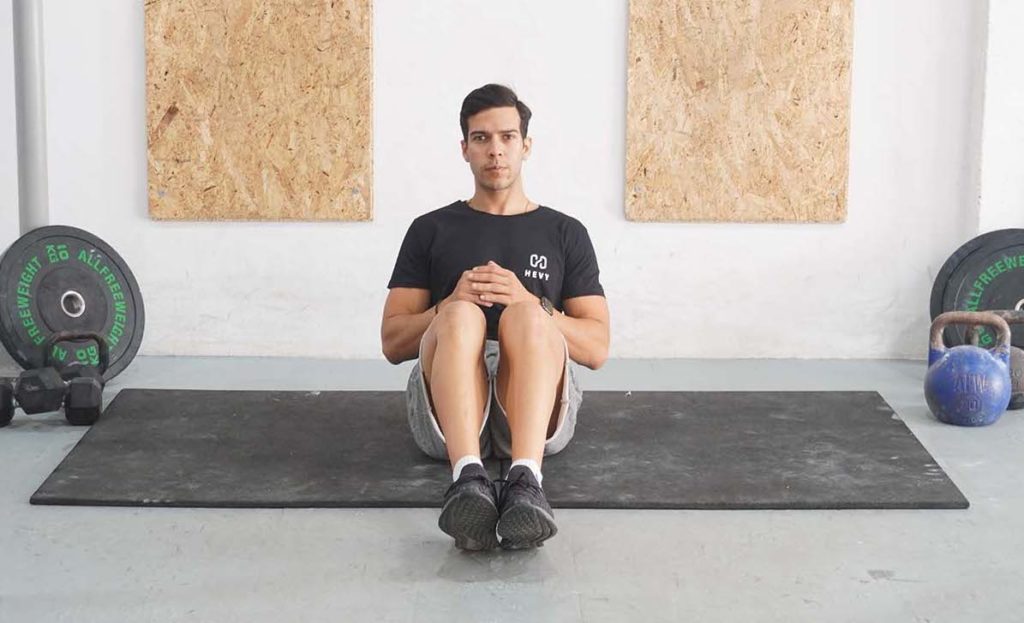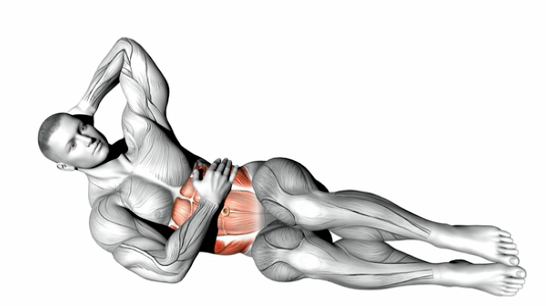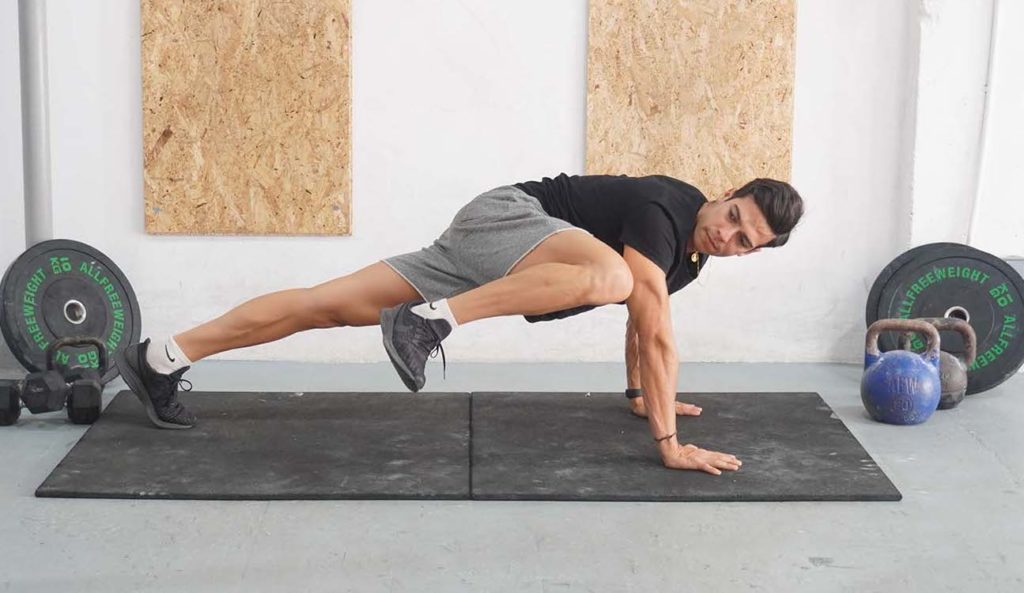Build a Strong Core with Russian Twists
Russian twists are an effective bodyweight core exercise that develops your rotational strength. The objective is to engage your abs and rotate your torso from side to side, which activates your obliques––the muscles running along both sides of your abs.
A notable benefit of the Russian twist is that the exercise improves core stability, allowing you to withstand external forces, such as while playing sports. Developing your obliques is also beneficial for your ability to throw, carry weights, and maintain proper posture.
The Russian twist is a highly functional movement that makes everyday tasks easier. For example, activities like carrying groceries and playing sports become easier since your obliques contribute to stability.
We recommend including the bodyweight version of Russian twists late into your workout, possibly as the last exercise. Do as many slow and controlled reps as you can, squeezing your midsection as you twist to each side.
Level of Exercise: Beginner
How to do Russian Twists
- Lay an exercise mat on the floor and sit down.
- Bring your legs together, have your knees bent, and lift your feet a couple of inches off the floor.
- As you lift your feet, lean slightly back, engaging your midsection.
- Maintain a neutral spine and avoid arching your lower back.
- Bring your hands together and in front of your chest.
- Take a breath and twist your torso to the left while keeping your hips steady.
- Twist, squeezing your abs at the top of the repetition and holding the position for a moment.
- Rotate your upper body back to the starting position as you exhale and breathe in again as you rotate to the other side.
- Keep rotating from left to right while keeping your feet a couple of inches off the floor throughout the exercise.
Alternatively, set yourself up inside a decline bench, lean back slightly, and rotate from side to side as you would on the floor.
What muscles does the Russian twist activate?
One of the primary muscles that work during a Russian twist is the abs (rectus abdominis) (1). The muscle group spans from just below the ribcage to the pelvic bone, and contracting it shortens the distance between the two. Our abs also contribute to stability, and their primary purpose during Russian twists is to engage and help us maintain a stable upper body.
Our internal and external obliques are the second pair of muscles involved in the Russian twist (2, 3). These muscles cover run along the length of our abs and play a crucial role in the rotation. Twisting to the side begins by engaging our obliques, forcing them to produce the necessary force.
The transverse abdominis also works during a Russian twist. Like the abs, the muscle’s primary function is to flex isometrically and provide support as we twist from side to side (4). But, unlike the abs, the transverse abdominis is a deep core muscle.
Our erector spinae is another collection of muscles with a passive role during Russian twists. The muscle group runs along both sides of the spine, promoting good posture. Similar to the rectus and transverse abdominis, the erector spinae flex isometrically to provide stability during the exercise.
How to Build Up Strength to do a Russian Twist
While relatively simple, the Russian twist is challenging for beginners who lack core strength. A simple way to make the exercise easier is to keep your feet planted on the floor. Doing so makes you more stable and reduces the tension on your abs because they don’t have to contract as hard to keep your feet in the air.
Another way to make twists easier is to keep your torso more upright. Similar to the previous technique tweak, a more upright upper body lessens the burden on your abs, allowing you to stay in position for longer and practice twisting to the left and right. If you struggle with the Russian twist, you can combine the two tactics and gradually work up to the full exercise.
As for proper technique, an essential tip to keep in mind is to focus on performing each repetition smoothly and through a full range of motion. You should feel your obliques engaging on every repetition, rather than twisting rapidly from side to side, trying to complete more reps.
Variations and Modifications of the Russian Twist (Bodyweight)
1. Russian Twist With Crossed Legs
Crossing your legs is a simple modification you can make to the Russian twist. Doing so isn’t essential, but you might find it easier to maintain your balance and feel your obliques as you twist from left to right. You have to cross your legs, lift your feet off the floor, and do the exercise as you usually would.
2. Decline Russian Twist
Decline twists are a simple variation you can perform on a bench. You have to position yourself on a decline bench, anchor your legs, and keep your spine neutral, similar to a decline crunch. Then, lean back as you would during a Russian twist on the floor and twist.
3. Russian Twists With Punches
The Russian twist with punches is a simple variation of the classic movement. You must punch in the direction of each twist instead of keeping your hands stationary. For example, as you twist to the left, extend your right arm into a punch while keeping your left hand close to your face. The variation isn’t anything special, but it can be a fun way to keep the exercise engaging.
Mistakes to Avoid

Focusing on Speed
A common mistake with the Russian twist is focusing on speed and your repetition count. Doing so takes your focus away from what truly matters: performing reps through a full range of motion and feeling the correct muscles activating on each twist. Avoid the error by slowing down and twisting your torso from one side to the other with purpose, even if it means doing fewer total repetitions.
Not Keeping Your Knees Stationary
The second mistake with a Russian twist is not keeping your knees stable as you twist from side to side. Aside from making it more challenging to stay in position, moving your knees makes it more difficult to engage your obliques. An excellent way to avoid the error is to practice the movement on a decline bench for a while. Anchoring your legs would prevent you from moving your knees, allowing you to learn the proper technique.
Arching Your Lower Back
The third common error with twists is arching your lower back. Doing so lengthens your abs, preventing you from engaging them throughout the movement. Avoid the mistake by drawing your belly button in as you engage your abs and maintaining that lumbar position during the Russian twist.
Similar Exercises to the Russian Twist
Cable Twist (Down to up)
Cable twists, also known as cable woodchops, are an effective exercise you can perform to strengthen your obliques and improve your rotational strength. The objective is to position the cable machine’s pulley low and attach a handle. Grab the handle with both hands, stand sideways, and rotate your torso out, moving the handle up in a diagonal path. Hold the position for a moment and bring your torso to the starting position.
Oblique Crunch

Oblique crunches are one of the easiest exercises beginners can do to strengthen their obliques and abs. One way to perform the movement is to lie on your side and engage your obliques to crunch your torso, lifting your bottom shoulder off the floor. Once finished, lie on your other side and perform the same number of reps.
Spiderman

The spiderman, also known as a spiderman plank, is another fantastic movement for your obliques and abs. You have to assume a push-up position, but instead of moving up and down, you must draw one knee to the back of your upper arm in one fluid motion. Extend the leg to the starting position and pull the opposite knee. Alternate between left and right until you finish the set.

